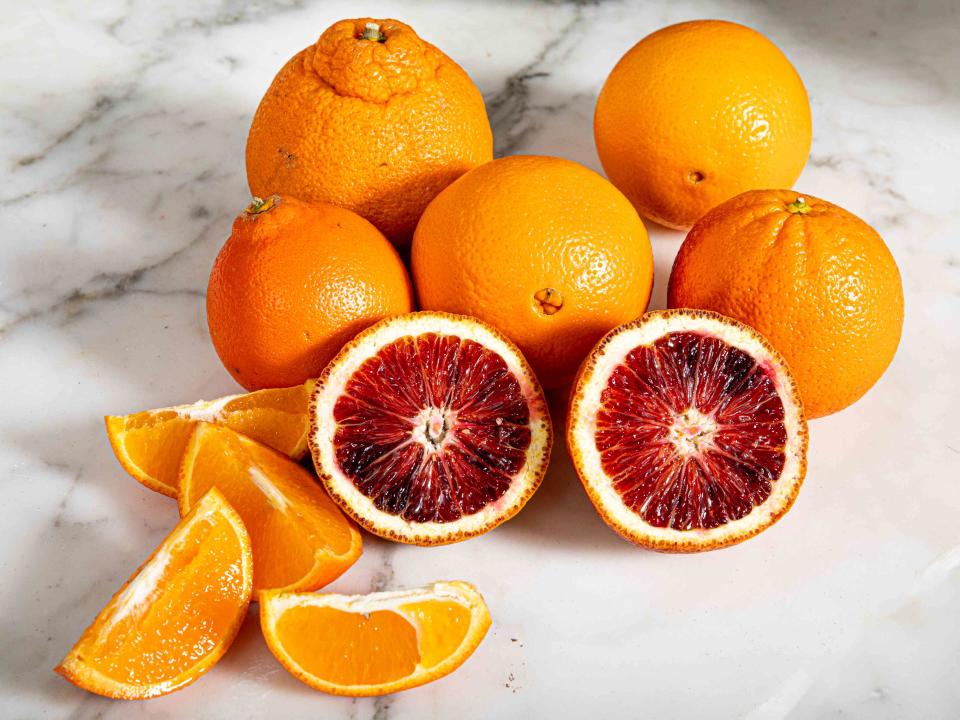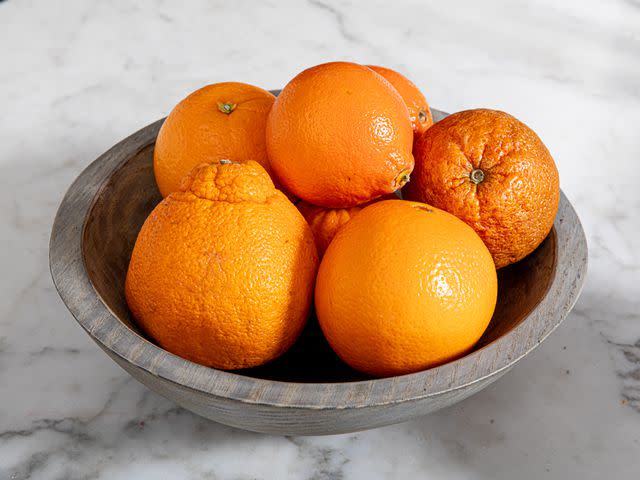How to Store Oranges Properly, According to a USDA Scientist
To find out the best way to store oranges, we ran a series of tests and spoke to a USDA scientist. One method was better than others.

Serious Eats / Amanda Suarez
TL;DR:
For maximum flavor and juiciness, oranges should be eaten within a few days of purchasing. But if you have to store them, refrigerating the citrus is the best way to prevent moisture loss and maintain texture and flavor.
When I was a kid, there was always a bag of navel oranges in our fridge. My parents never stored their oranges any other way, and because our family went through the fruit so quickly, the citrus never went bad. It never molded, it never shriveled, and it never, ever went uneaten. Simply put, my family had no reason to think of the “best way” to store them. But as a citrus lover and an editor at a food publication known for its limitless curiosity, I wanted to know: What is the best way to keep oranges so they remain delicious for as long as possible?
To find out, I ran a series of tests and talked to a plant physiologist and citrus expert at the U.S. Department of Agriculture for further insight. Despite a range of common storage methods in an orange's supply chain—cold storage in warehouses and transport, room temp in many grocery stores—there’s one home storage method that’s far better than others at maintaining the best flavor and texture of oranges.
An Orange’s Journey From Grove to Grocery Store
Orange growers, wholesalers, and retailers all strive to preserve the fruit as long as possible while maintaining quality. Unlike many fruits that continue ripening after they’re harvested, oranges are picked at peak maturity and don’t improve once they’re off the tree. Once picked, there are two major threats to the fruit's longevity: microbes that can hasten spoilage, and the natural ongoing respiration of the fruit that, while essential to its growth and maturation, eventually contributes to a decline in flavor and texture.
To address this, the oranges are first sent to processing plants, where they're washed in a disinfectant—usually a mixture of chlorine and water, followed by a fungicide—to rid the fruit of any surface microbes that could cause premature rot.
As oranges ripen, they naturally produce a wax that fills tiny pores on the skin, which slows the rate of respiration and moisture loss through those pores. During the disinfecting step, though, that natural wax is washed away. So the oranges are then coated in a new layer of wax to reseal the skin and prolong shelf life.
After the oranges are washed and waxed, fruit processors keep the citrus in cold storage and ship them in refrigerated containers, because cold is another method of slowing respiration and increasing the orange's time as a delicious, juicy fruit. “The key to the whole thing is that the fruit is kept cold as long as possible,” Dr. David Obenland, a plant physiologist at the USDA, tells me. He adds that the ideal temperature for storing oranges is about 41ºF (5ºC), though this may vary depending on the citrus variety.
If it’s so crucial to refrigerate oranges, though, why do grocery stores keep them at room temperature while maintaining such seemingly pristine condition? “The citrus in the grocery store generally looks good because people are continually buying it and it is being replenished with new fruit and fruit that go bad are removed,” Dr. Obenland says. “I have never been in the back room of a grocery store, but I am assuming that they have coolers and freezers there to store product until it is needed.”

Serious Eats / Amanda Suarez
The Testing
Based on all my research, it’s pretty clear that keeping citrus cold is preferable. To confirm this on a practical level, I ran a series of tests on orange storage in my own home. I tested refrigerating the oranges against holding them at room temperature washing versus not washing them; and whether keeping them loosely sealed in a plastic bag versus not bagged made a difference.
To assess these storage methods, I measured moisture loss by recording the mass of each orange daily over the course of the tests, and also conducted visual inspections, making note of how they looked, felt, and smelled. After two weeks, I cut into the oranges and tasted each to determine how storage related to their flavor and juiciness.
Room Temperature vs. Fridge
To put it simply: room temperature citrus did not fare well. On average, the oranges held at room temperature lost 6% of their total weight compared to the 3% of their refrigerated counterparts. While the refrigerated oranges felt pretty firm throughout the tests, the room temperature oranges grew noticeably softer. As the days went on, the texture of the room-temp peels increasingly reminded me of the giant foam fingers you see at sports games. In the course of my testing, I also lost two room-temperature oranges to rot about halfway through the two week test; none of the refrigerated oranges succumbed in the same way.
With the exception of the moldy oranges—which I tossed at the first sign of decay—the rest of the room temperature oranges looked passable, if a bit tired, at the end of the test. Someone who didn’t know they’d been sitting at room temperature for two weeks would probably assume they’re fine to eat. But upon cutting into them, I saw that most of the flesh was dried and shriveled; these oranges were not juicy and they did not taste good, with a flavor that was old and musty.
The refrigerated oranges, which I kept on a 9- by 13- inch baking sheet on the middle shelf of my fridge, held up a lot better. Their peels felt firm and they looked almost as good as they did on the first day. When tasted after two weeks, they were still sweet and juicy, but had lost some of their acidic kick. This aligns with my research and what I learned from talking with Dr. Obenland: For optimal flavor and longevity, store your oranges in the refrigerator.
Washing vs. No Washing
Just as washing strawberries helps them stay mold-free for longer, I wanted to see if washing oranges would make a difference—especially since two of the room temperature oranges molded halfway through the test. I rinsed my oranges in tap water and dried them with a towel, and like my previous test, kept half of them at room temperature and half of them in the fridge.
Between the washed and unwashed oranges, the flavor tracked with my temperature tests irrespective of washing status: It was better preserved in the fridge and did not hold up well at room temperature. Washing also didn't seem to have a significant impact on moisture loss, but it did seem to help prevent the oranges at room temperature from decaying. All the oranges made it through the whole test without any mold—but this ultimately doesn’t matter given that room temperature storage still leads to worse flavor and texture over time.
Practically speaking, as long as your oranges are in the fridge, there’s really not much benefit to washing them.
Bagged vs. No Bag
The next test I wanted to run was bagging the citrus. I tested by placing oranges in a regular plastic produce bag from the grocery store. To ensure there’d still be some air flow, I loosely tied the bag (a bag that’s sealed shut may trap unwanted moisture and gas, leading to rot). The bagged fruit, which lost just an average 1% of its total weight, showed the least amount of moisture loss, while the unbagged fruit lost an average of 4% of its total weight. On a practical, qualitative level, I honestly could not tell the difference when tasting the refrigerated fruit side by side. Refrigerating fruit in a bag may help slightly, but the difference was pretty negligible—and considering how wasteful single-use plastic is, I hesitate to recommend storing your fruit in a plastic bag.
The main takeaway from all my research and testing? Just refrigerate your oranges and, of course, eat them sooner than later.
Read the original article on Serious Eats.

